be动词的一般现在时有三种形式
什么时候用be动词什么时候用do和does
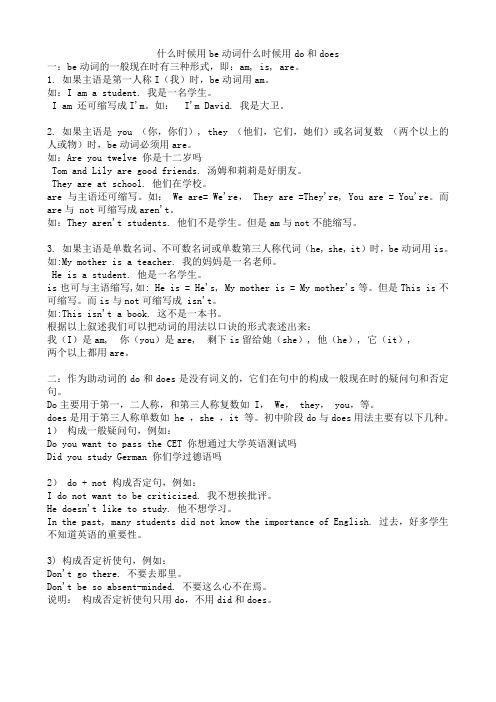
什么时候用be动词什么时候用do和does一:be动词的一般现在时有三种形式,即:am, is, are。
1. 如果主语是第一人称I(我)时,be动词用am。
如:I am a student. 我是一名学生。
I am 还可缩写成I'm。
如: I'm David. 我是大卫。
2. 如果主语是you (你,你们), they (他们,它们,她们)或名词复数(两个以上的人或物)时,be动词必须用are。
如:Are you twelve 你是十二岁吗Tom and Lily are good friends. 汤姆和莉莉是好朋友。
They are at school. 他们在学校。
are与主语还可缩写。
如: We are= We're, They are =They're, You are = You're。
而are与 not可缩写成aren't。
如:They aren't students. 他们不是学生。
但是am与not不能缩写。
3. 如果主语是单数名词、不可数名词或单数第三人称代词(he, she, it)时,be动词用is。
如:My mother is a teacher. 我的妈妈是一名老师。
He is a student. 他是一名学生。
is也可与主语缩写,如: He is = He's, My mother is = My mother's等。
但是This is不可缩写。
而is与not可缩写成 isn't。
如:This isn't a book. 这不是一本书。
根据以上叙述我们可以把动词的用法以口诀的形式表述出来:我(I)是am, 你(you)是are, 剩下is留给她(she), 他(he), 它(it),两个以上都用are。
二:作为助动词的do和does是没有词义的,它们在句中的构成一般现在时的疑问句和否定句。
be动词用法 - 用于合并
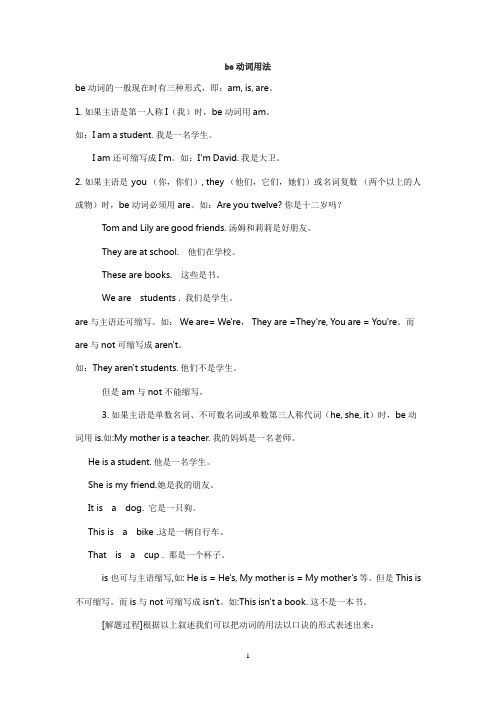
be动词用法be动词的一般现在时有三种形式,即:am,is,are。
1.如果主语是第一人称I(我)时,be动词用am。
如:I am a student.我是一名学生。
I am还可缩写成I'm。
如:I'm David.我是大卫。
2.如果主语是you(你,你们),they(他们,它们,她们)或名词复数(两个以上的人或物)时,be动词必须用are。
如:Are you twelve?你是十二岁吗?Tom and Lily are good friends.汤姆和莉莉是好朋友。
They are at school.他们在学校。
These are books. 这些是书。
We are students . 我们是学生。
are与主语还可缩写。
如:We are=We're,They are=They're,You are=You're。
而are 与not可缩写成aren't。
如:They aren't students.他们不是学生。
但是am与not不能缩写。
3.如果主语是单数名词、不可数名词或单数第三人称代词(he,she,it)时,be动词用is.如:My mother is a teacher.我的妈妈是一名老师。
He is a student.他是一名学生。
She is my friend.她是我的朋友。
It is a dog. 它是一只狗。
This is a bike .这是一辆自行车。
That is a cup . 那是一个杯子。
is也可与主语缩写,如:He is=He's,My mother is=My mother's等。
但是This is 不可缩写。
而is与not可缩写成isn't。
如:This isn't a book.这不是一本书。
[解题过程]根据以上叙述我们可以把动词的用法以口诀的形式表述出来:我(I)是am,你(you)是are,剩下is留给她(she),他(he),它(it),两个以上都用are。
be动词一般现在时有三种形式

be动词的一般现在时有三种形式,即:am, is, are(翻译为“是”)1. 如果主语是第一人称I(我)时,be动词用am。
如:I am a student. 我是一名学生。
I am 还可缩写成I'm。
如:I'm David. 我是大卫。
am 与 not 不能缩写。
如:I am not a bad boy.2. 如果主语是we(我们),you (你,你们), they (他们,它们,她们)或名词复数(两个以上的人或物)时,be动词必须用are。
如:Are you twelve? 你是十二岁吗?Tom and Lily are good friends. 汤姆和莉莉是好朋友。
They are at school. 他们在学校。
are与主语还可缩写。
如: We are= We're, They are =They're, You are = You're。
而are与 not可缩写成aren't。
如:They aren't students. 他们不是学生。
3. 如果主语是单数名词、不可数名词或单数第三人称代词(he, she, it)时,be动词用is。
如:My mother is a teacher. 我的妈妈是一名老师。
He is a student. 他是一名学生。
is也可与主语缩写,如: He is = He's, My mother is = My mother's 等。
但是This is不可缩写。
而is与not可缩写成 isn't。
如:This isn't a book. 这不是一本书。
4. 句中含有be动词的陈述句变一般疑问句。
把be动词提到句首,be动词要变大写。
注意第一人称变第二人称。
回答时用yes或no表示,结构:Yes, 主语+be动词,No,主语+be动词+not。
如:It is a book. 变为:Is it a book?5. 句中含有be动词的肯定陈述句变否定句。
be动词的使用方法

3. 如果主语是单数名词、不可数名词或单数第三 人称代词(he, she, it)时,be动词用is。
如:My mother is a teacher. 我的妈妈是一名老师。
He is a student. 他是一名学生。
如:Are you twelve? 你是十二岁吗?
Tom and Lily are good friends. 汤姆和莉莉是好朋友。
They are at school. 他们在学校。
are与主语还可缩写。如: We are= We're, They are =They're, You are = You're。而are与 not可缩写成aren't。
Be动词的使用方法
魏钢
be动词的一般现在时有三种形式, 即:am, is, are。
1. 如果主语是第一人称I(我)时,be动词 用am。
如:I am a student. 我是一名学生。
I am 还可缩写成I'm。如:
I'm David. 我是大卫。
2. 如果主语是you (你,你们), they (他们,它们,她们) 或名词复数 (两个以上的人或物)时,be动词必须用are。
请用isI _a_m__ a good student. 2. You _a_r_e_not a teacher. 3. __Is___ he a doctor? 4. Tom and Lin Tao _a_r_e__ good friends. 5.The dog ___i_s___ tall and fat.
Thanks for your attention!
be动词的基本用法

be动词的⼀一般现在时有三种形式,即:am, is, are。
1. 如果主语是第⼀一⼈人称I(我)时,be动词⽤用am。
如:I am a student. 我是⼀一名学⽣生。
I am 还可缩写成I'm。
如:I'm David. 我是⼤大卫。
2. 如果主语是you (你,你们), they (他们,它们,她们)或名词复数(两个以上的⼈人或物)时,be动词必须⽤用are。
如:Are you twelve? 你是⼗十⼆二岁吗?Tom and Lily are good friends. 汤姆和莉莉是好朋友。
They are at school. 他们在学校。
are与主语还可缩写。
如: We are= We're, They are =They're, You are = You're。
⽽而are与 not可缩写成aren't。
如:They aren't students. 他们不是学⽣生。
但是am与not不能缩写。
3. 如果主语是单数名词、不可数名词或单数第三⼈人称代词(he, she, it)时,be动词⽤用is。
如:My mother is a teacher. 我的妈妈是⼀一名⽼老师。
He is a student. 他是⼀一名学⽣生。
is也可与主语缩写,如: He is = He's, My mother is = My mother's等。
但是This is不可缩写。
⽽而is与not可缩写成 isn't。
如:This isn't a book. 这不是⼀一本书。
根据以上叙述我们可以把动词的⽤用法以⼝口诀的形式表述出来:我(I)是am,你(you)是are,剩下is留给她(she), 他(he), 它(it),两个以上都⽤用are。
[思路分析]be作助动词⽤用的形式如下:①am, is, are, was, were②助动词+be:shall be, will be, can be, etc.③have/has/had + been(完成时)④am, is, ⋯being(进⾏行时)[解题过程](1)表达进⾏行时态句型 be + V-ing⋯(进⾏行时态)例:What are you reading?(你正在阅读什么?)I am reading a magazine.(我正在阅读杂志。
be动词的一般现在时有三种形式
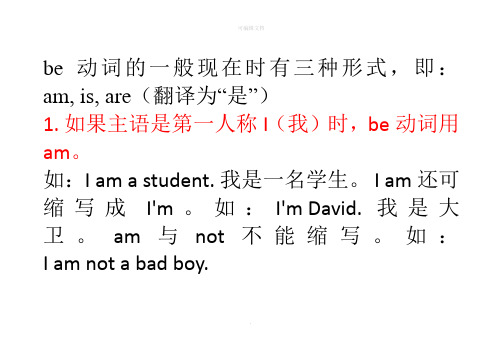
be动词的一般现在时有三种形式,即:am, is, are(翻译为“是”)1. 如果主语是第一人称I(我)时,be动词用am。
如:I am a student. 我是一名学生。
I am 还可缩写成I'm。
如:I'm David. 我是大卫。
am 与 not 不能缩写。
如:I am not a bad boy..2. 如果主语是we(我们),you (你,你们), they (他们,它们,她们)或名词复数(两个以上的人或物)时,be动词必须用are。
如:Are you twelve? 你是十二岁吗?Tom and Lily are good friends. 汤姆和莉莉是好朋友。
They are at school. 他们在学校。
are与主语还可缩写。
.如: We are= We're, They are =They're, You a re = You're。
而are与 not可缩写成aren't。
如:They aren't students. 他们不是学生。
3. 如果主语是单数名词、不可数名词或单数第三人称代词(he, she, it)时,be动词用is。
如:My mother is a teacher. 我的妈妈是一名老师。
He is a student. 他是一名学生。
is也可与主语缩写,.如: He is = He's, My mother is = My mother's 等。
但是This is不可缩写。
而is与not可缩写成 isn't。
如:This isn't a book. 这不是一本书。
4. 句中含有be动词的陈述句变一般疑问句。
把be动词提到句首,be动词要变大写。
注意第一人称变第二人称。
回答时用yes或no表示,结构:Yes, 主语+be动词,No,主语+be动词+not。
如:It is a book. 变为:.Is it a book?5. 句中含有be动词的肯定陈述句变否定句。
英语be怎么用介绍
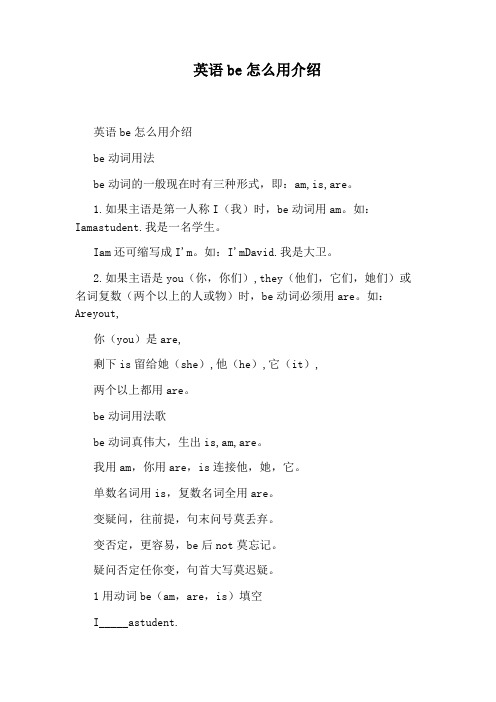
英语be怎么用介绍英语be怎么用介绍be动词用法be动词的一般现在时有三种形式,即:am,is,are。
1.如果主语是第一人称I(我)时,be动词用am。
如:Iamastudent.我是一名学生。
Iam还可缩写成I'm。
如:I'mDavid.我是大卫。
2.如果主语是you(你,你们),they(他们,它们,她们)或名词复数(两个以上的人或物)时,be动词必须用are。
如:Areyout,你(you)是are,剩下is留给她(she),他(he),它(it),两个以上都用are。
be动词用法歌be动词真伟大,生出is,am,are。
我用am,你用are,is连接他,她,它。
单数名词用is,复数名词全用are。
变疑问,往前提,句末问号莫丢弃。
变否定,更容易,be后not莫忘记。
疑问否定任你变,句首大写莫迟疑。
1用动词be(am,are,is)填空I_____astudent.LucyandLily____fromUSA.---Who___they?---They____Jim,MikeandJohn.Thewhiteshirts_____onthechair.Theirbikes____underabigtree.Hisfather___athome.Howold_____you?______thereanybirdsinthetree?2选择填空---Whatclass___youin?---I_____inClassOne. Aare;areBare;amCare;isThey____newstudents.We____notnew.Aare;areBare;amCare;is---Where____hispencils?---Oh,inhisbag. AisBareCamMissGao_____ourteacher.She____tall.Aare;areBare;isCis;isTheirclassroom______overthere.AareBisCamIthinkAnnandBetty_____intheclassroom. AisBamCareBe动词的用法及介绍“Be”动词的意思是”是”,它随人称的`变化而变化.1.be动词属于系动词,在句子中主要表现为三种形式:am、is、are。
be动词的一般现在时有三种形式1
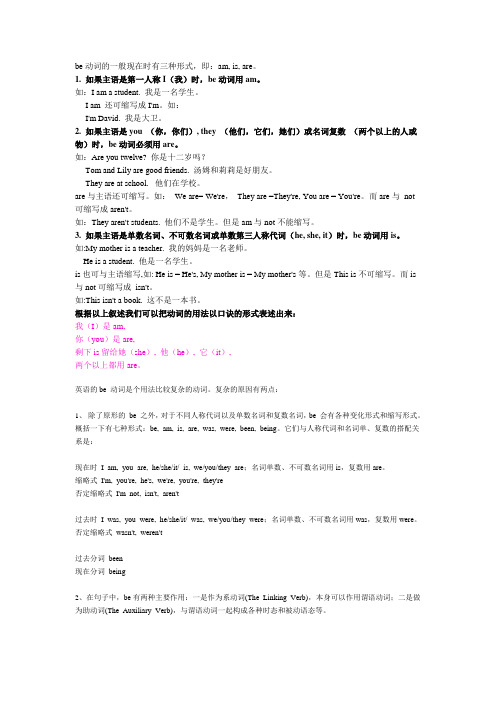
be动词的一般现在时有三种形式,即:am, is, are。
1. 如果主语是第一人称I(我)时,be动词用am。
如:I am a student. 我是一名学生。
I am 还可缩写成I'm。
如:I'm David. 我是大卫。
2. 如果主语是you (你,你们), they (他们,它们,她们)或名词复数(两个以上的人或物)时,be动词必须用are。
如:Are you twelve? 你是十二岁吗?Tom and Lily are good friends. 汤姆和莉莉是好朋友。
They are at school. 他们在学校。
are与主语还可缩写。
如:We are= We're,They are =They're, You are = You're。
而are与not可缩写成aren't。
如:They aren't students. 他们不是学生。
但是am与not不能缩写。
3. 如果主语是单数名词、不可数名词或单数第三人称代词(he, she, it)时,be动词用is。
如:My mother is a teacher. 我的妈妈是一名老师。
He is a student. 他是一名学生。
is也可与主语缩写,如: He is = He's, My mother is = My mother's等。
但是This is不可缩写。
而is 与not可缩写成isn't。
如:This isn't a book. 这不是一本书。
根据以上叙述我们可以把动词的用法以口诀的形式表述出来:我(I)是am,你(you)是are,剩下is留给她(she), 他(he), 它(it),两个以上都用are。
英语的be 动词是个用法比较复杂的动词。
复杂的原因有两点:1、除了原形的be 之外,对于不同人称代词以及单数名词和复数名词,be 会有各种变化形式和缩写形式。
什么时候用be动词什么时候用do和does
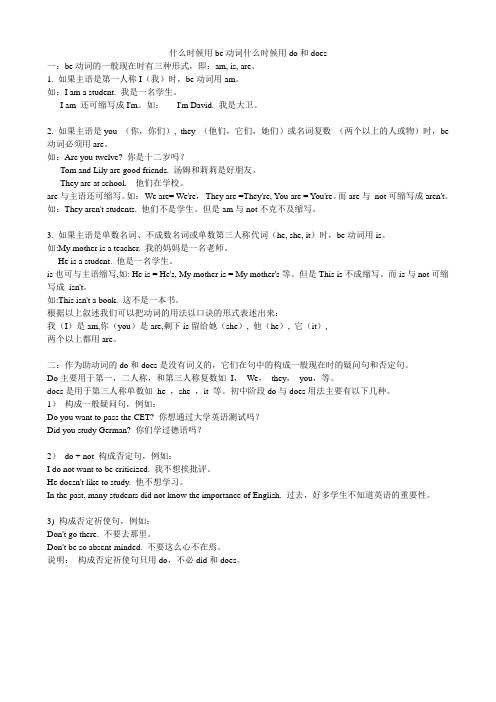
什么时候用be动词什么时候用do和does一:be动词的一般现在时有三种形式,即:am, is, are。
1. 如果主语是第一人称I(我)时,be动词用am。
如:I am a student. 我是一名学生。
I am 还可缩写成I'm。
如:I'm David. 我是大卫。
2. 如果主语是you (你,你们), they (他们,它们,她们)或名词复数(两个以上的人或物)时,be 动词必须用are。
如:Are you twelve? 你是十二岁吗?Tom and Lily are good friends. 汤姆和莉莉是好朋友。
They are at school. 他们在学校。
are与主语还可缩写。
如:We are= We're,They are =They're, You are = You're。
而are与not可缩写成aren't。
如:They aren't students. 他们不是学生。
但是am与not不克不及缩写。
3. 如果主语是单数名词、不成数名词或单数第三人称代词(he, she, it)时,be动词用is。
如:My mother is a teacher. 我的妈妈是一名老师。
He is a student. 他是一名学生。
is也可与主语缩写,如: He is = He's, My mother is = My mother's等。
但是This is不成缩写。
而is与not可缩写成isn't。
如:This isn't a book. 这不是一本书。
根据以上叙述我们可以把动词的用法以口诀的形式表述出来:我(I)是am,你(you)是are,剩下is留给她(she), 他(he), 它(it),两个以上都用are。
二:作为助动词的do和does是没有词义的,它们在句中的构成一般现在时的疑问句和否定句。
用be动词造句
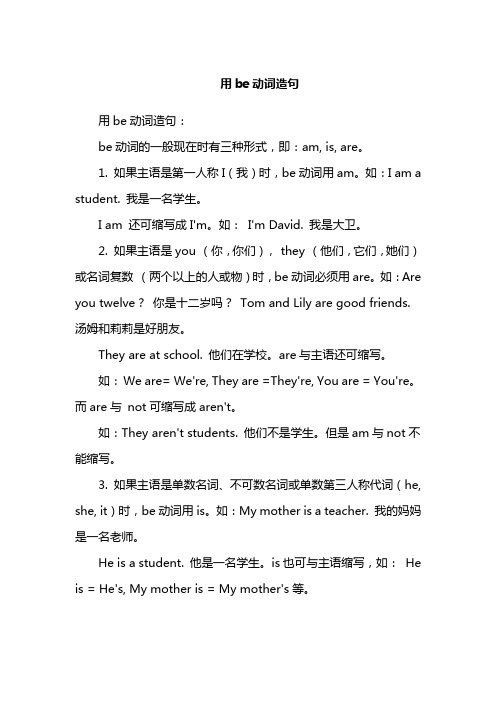
用be动词造句
用be动词造句:
be动词的一般现在时有三种形式,即:am, is, are。
1. 如果主语是第一人称I(我)时,be动词用am。
如:I am a student. 我是一名学生。
I am 还可缩写成I'm。
如:I'm David. 我是大卫。
2. 如果主语是you (你,你们),they (他们,它们,她们)或名词复数(两个以上的人或物)时,be动词必须用are。
如:Are you twelve?你是十二岁吗?Tom and Lily are good friends. 汤姆和莉莉是好朋友。
They are at school. 他们在学校。
are与主语还可缩写。
如:We are= We're, They are =They're, You are = You're。
而are与not可缩写成aren't。
如:They aren't students. 他们不是学生。
但是am与not不能缩写。
3. 如果主语是单数名词、不可数名词或单数第三人称代词(he, she, it)时,be动词用is。
如:My mother is a teacher. 我的妈妈是一名老师。
He is a student. 他是一名学生。
is也可与主语缩写,如:He is = He's, My mother is = My mother's等。
Be动词的用法1
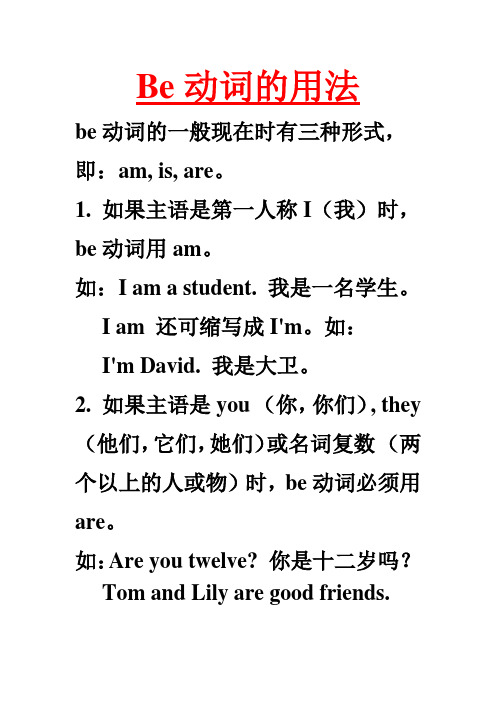
Be动词的用法be动词的一般现在时有三种形式,即:am, is, are。
1. 如果主语是第一人称I(我)时,be动词用am。
如:I am a student. 我是一名学生。
I am 还可缩写成I'm。
如:I'm David. 我是大卫。
2. 如果主语是you (你,你们), they (他们,它们,她们)或名词复数(两个以上的人或物)时,be动词必须用are。
如:Are you twelve? 你是十二岁吗?Tom and Lily are good friends.汤姆和莉莉是好朋友。
They are at school. 他们在学校。
are与主语还可缩写。
如:We are= We're,They are =They're, You are = You're。
而are与not可缩写成aren't。
如:They aren't students. 他们不是学生。
但是am与not不能缩写。
3. 如果主语是单数名词、不可数名词或单数第三人称代词(he, she, it)时,be动词用is。
如:My mother is a teacher. 我的妈妈是一名老师。
He is a student. 他是一名学生。
is也可与主语缩写,如: He is = He's, My mother is = My mother's等。
但是This is不可缩写。
而is与not可缩写成isn't。
如:This isn't a book. 这不是一本书。
根据以上叙述我们可以把动词的用法以口诀的形式表述出来:我(I)用am,你(you)用are,is连着她(she), 他(he), 它(it), 单数名词用is ,复数名词全用are。
(完整word版)be动词用法

be动词用法be动词的一般现在时有三种形式,即:am, is,are.1. 如果主语是第一人称I(我)时,be动词用am。
如:I am a student。
我是一名学生。
I am 还可缩写成I’m。
如:I'm David。
我是大卫。
2。
如果主语是you (你,你们), they (他们,它们,她们)或名词复数(两个以上的人或物)时,be动词必须用are.如:Are you twelve? 你是十二岁吗?Tom and Lily are good friends。
汤姆和莉莉是好朋友。
They are at school。
他们在学校。
These are books. 这些是书.We are students 。
我们是学生。
are与主语还可缩写。
如:We are= We're,They are =They’re,You are = You're。
而are与not可缩写成aren’t。
如:They aren't students。
他们不是学生.但是am与not不能缩写。
3. 如果主语是单数名词、不可数名词或单数第三人称代词(he,she, it)时,be动词用is.如:My mother is a teacher. 我的妈妈是一名老师。
He is a student。
他是一名学生。
She is my friend.她是我的朋友.It is a dog。
它是一只狗。
This is a bike 。
这是一辆自行车。
That is a cup 。
那是一个杯子。
is也可与主语缩写,如: He is = He's,My mother is = My mother's等.但是This is不可缩写.而is与not可缩写成isn’t。
如:This isn't a book。
这不是一本书.[解题过程]根据以上叙述我们可以把动词的用法以口诀的形式表述出来:我(I)是am,你(you)是are,剩下is留给她(she), 他(he),它(it),两个以上都用are。
be动词的基本用法

be动词的⼀一般现在时有三种形式,即:am, is, are。
1. 如果主语是第⼀一⼈人称I(我)时,be动词⽤用am。
如:I am a student. 我是⼀一名学⽣生。
I am 还可缩写成I'm。
如:I'm David. 我是⼤大卫。
2. 如果主语是you (你,你们), they (他们,它们,她们)或名词复数(两个以上的⼈人或物)时,be动词必须⽤用are。
如:Are you twelve? 你是⼗十⼆二岁吗?Tom and Lily are good friends. 汤姆和莉莉是好朋友。
They are at school. 他们在学校。
are与主语还可缩写。
如: We are= We're, They are =They're, You are = You're。
⽽而are与 not可缩写成aren't。
如:They aren't students. 他们不是学⽣生。
但是am与not不能缩写。
3. 如果主语是单数名词、不可数名词或单数第三⼈人称代词(he, she, it)时,be动词⽤用is。
如:My mother is a teacher. 我的妈妈是⼀一名⽼老师。
He is a student. 他是⼀一名学⽣生。
is也可与主语缩写,如: He is = He's, My mother is = My mother's等。
但是This is不可缩写。
⽽而is与not可缩写成 isn't。
如:This isn't a book. 这不是⼀一本书。
根据以上叙述我们可以把动词的⽤用法以⼝口诀的形式表述出来:我(I)是am,你(you)是are,剩下is留给她(she), 他(he), 它(it),两个以上都⽤用are。
[思路分析]be作助动词⽤用的形式如下:①am, is, are, was, were②助动词+be:shall be, will be, can be, etc.③have/has/had + been(完成时)④am, is, ⋯being(进⾏行时)[解题过程](1)表达进⾏行时态句型 be + V-ing⋯(进⾏行时态)例:What are you reading?(你正在阅读什么?)I am reading a magazine.(我正在阅读杂志。
初中英语be动词用法

be动词用法be动词的一般现在时有三种形式,即:am,is,are。
1.如果主语是第一人称I(我)时,be动词用am。
如:I am a student.我是一名学生。
I am还可缩写成I'm。
如:I'm David.我是大卫。
2.如果主语是you(你,你们),they(他们,它们,她们)或名词复数(两个以上的人或物)时,be动词必须用are。
如:Are you twelve?你是十二岁吗?Tom and Lily are good friends.汤姆和莉莉是好朋友。
They are at school. 他们在学校。
These are books. 这些是书。
We are students . 我们是学生。
are与主语还可缩写。
如:We are=We're,They are=They're,You are=You 're。
而are与not可缩写成aren't。
如:They aren't students.他们不是学生。
但是am与not不能缩写。
3.如果主语是单数名词、不可数名词或单数第三人称代词(he,she,it)时,be动词用is.如:My mother is a teacher.我的妈妈是一名老师。
He is a student.他是一名学生。
She is my friend.她是我的朋友。
It is a dog. 它是一只狗。
This is a bike .这是一辆自行车。
That is a cup . 那是一个杯子。
is也可与主语缩写,如:He is=He's,My mother is=My mother's等。
但是This is不可缩写。
而is与not可缩写成isn't。
如:This isn't a book.这不是一本书。
[解题过程]根据以上叙述我们可以把动词的用法以口诀的形式表述出来:我(I)是am,你(you)是are,剩下is留给她(she),他(he),它(it),两个以上都用are。
- 1、下载文档前请自行甄别文档内容的完整性,平台不提供额外的编辑、内容补充、找答案等附加服务。
- 2、"仅部分预览"的文档,不可在线预览部分如存在完整性等问题,可反馈申请退款(可完整预览的文档不适用该条件!)。
- 3、如文档侵犯您的权益,请联系客服反馈,我们会尽快为您处理(人工客服工作时间:9:00-18:30)。
be动词的一般现在时有三种形式,即:am, is, are。
1. 如果主语是第一人称I(我)时,be动词用am。
如:I am a student. 我是一名学生。
I am 还可缩写成I'm。
如:I'm David. 我是大卫。
2. 如果主语是you (你,你们), they (他们,它们,她们)或名词复数(两个以上的人或物)时,be动词必须用are。
如:Are you twelve? 你是十二岁吗?Tom and Lily are good friends. 汤姆和莉莉是好朋友。
They are at school. 他们在学校。
are与主语还可缩写。
如:We are= We're,They are =They're, You are = You're。
而are与not可缩写成aren't。
如:They aren't students. 他们不是学生。
但是am与not不能缩写。
3. 如果主语是单数名词、不可数名词或单数第三人称代词(he, she, it)时,be动词用is。
如:My mother is a teacher. 我的妈妈是一名老师。
He is a student. 他是一名学生。
is也可与主语缩写,如: He is = He's, My mother is = My mother's等。
但是This is不可缩写。
而is 与not可缩写成isn't。
如:This isn't a book. 这不是一本书。
根据以上叙述我们可以把动词的用法以口诀的形式表述出来:我(I)是am,你(you)是are,剩下is留给她(she), 他(he), 它(it),两个以上都用are。
英语的be 动词是个用法比较复杂的动词。
复杂的原因有两点:1、除了原形的be 之外,对于不同人称代词以及单数名词和复数名词,be 会有各种变化形式和缩写形式。
概括一下有七种形式:be, am, is, are, was, were, been, being。
它们与人称代词和名词单、复数的搭配关系是:现在时I am, you are, he/she/it/ is, we/you/they are;名词单数、不可数名词用is,复数用are。
缩略式I'm, you're, he's, we're, you're, they're否定缩略式I'm not, isn't, aren't过去时I was, you were, he/she/it/ was, we/you/they were;名词单数、不可数名词用was,复数用were。
否定缩略式wasn't, weren't过去分词been现在分词being2、在句子中,be有两种主要作用:一是作为系动词(The Linking Verb),本身可以作用谓语动词;二是做为助动词(The Auxiliary Verb),与谓语动词一起构成各种时态和被动语态等。
下面做个简要的讲解。
一、be 动词做系动词1、系动词+表语”的结构当be 动词做系动词使用时,主要构成“系动词+表语”的结构,在句子中做谓语。
表语可以是名词、形容词、副词、介词短语等。
例如:The man is a science teacher.Mary's new dresses are colourful.Mother is in the kitchen now.I have been there before.They shall be here at 10:00 tommorow.That can't be true.You are not being very polite.Your brother is being very annoying this evening2、be 动词的一般疑问句,方法是把be 移到主语前面,也可说成是移到句首。
Is the man a science teacher? Yes, he is. / No, he isn't.Are Mary's new dresses colourful? Yes, they are. / No, they aren't.Was mother in the kitchen then? Yes, she was. / No, she wasn't.Were you at home the day before yesterday? Yes, I was. / No, I wasn't.Was she late this morning? Yes, she was. / No, she wasn't.3、be 动词用在特殊疑问句在特殊疑问句里,be 动词仍然移到主语前面,但特殊疑问句是以特殊疑问词开头的,所以be 动词只能说是移到主语前面,或者说是在特殊疑问词的后面。
例如:Whose bike is broken? Xiao Ming's bike is.Who was singing in the room? Mr. Zhang was.Where are you from? I am from Wuhu.What class were you in? We were in Class 2.How old is Tom? He is ten.4、be 动词的否定句be 动词做谓语时,它的否定形式是在be 后加not,并且可以缩写。
例如:It is not sunny today.Tom and his friends are not in the park.You were not nine years old when I went to the university.He was not often late for his class when he was a student.I wasn't here yesterday.My parents weren't at home last Sunday.5、be 动词的祈使句be 动词的祈使句有肯定和否定两种形式。
肯定形式是以be 动词开头,而否定形式或强调句形,要加don' t 或do。
例如:Be careful!Be a good boy!Don't be silly!Don't be a fool!Do be obedient!Do be careful.二、be 动词做助动词助动词be 有两个基本用法,一是与谓语动词一起构成各种时态,二是构成被动语态。
1、“be + 现在分词组”成各种进行式时态。
例如:Tony's maid is washing his new car.The children are playing in the field.Samuel was eating when I came in.We have been living here since 1959.This time next day they will be sitting in the cinema.2、“be + 过去分词”组成被动语态。
例如:Her money in the drawer was stolen.A number of good jobs are taken up byforeigners.David studied in Taiwan but has been trained as a language lecturer in America.The disobedient boy was told to stand out- side the classroom.Steps are being taken to reduce traffic con- gestion during peak hours.Dishonest students will be immediately dealt with.3、being 的分词短语being 也是be 的变化形式之一,它是be 动词的现在分词。
being 一般不单独使用,而是构成“系+表”结构的分词短语,或者构成被动语态的短语。
一般情况下,可以把being短语作为一个词组来整体看待,它在句子中可以作为各种成份,比如主语、表语、定语、状语等。
从大的方面说,being短语属于另外一个语法项目,即:现在分词(短语)的用法。
关于分词(短语)的用法,请参看本站有关文章。
这里,结合全句做一点简单的提示。
例如:Your brother is being very annoying this evening. (表语)Being lost can be a terrifying experience. (主语)He can't stand being kept waiting. (宾语)Did you see that boy being questioned by the police? (定语)Being given a chance, she immediately jumped at it. (状语)The question being settled, we went home. (构成独立主格结构)三、注意事项英语句子中,为了表达时态或被动语态的需要,常常会出现几个助动词连在一块儿使用。
也就是说,助动词be会和其它助动词一起使用。
这时候,整个句子的一般疑问句和否定句,就不一定是对be 进行变化了,而是以第一个助动词为主进行变化。
即哪个助动词在先,就以它为主进行变化。
例如:[肯定句] All the wonderful birds can be found in our Bird Park. (助动词有两个:can be )[疑问句] Can all the wonderful birds be found in our Bird Park? (移第一个can)[否定句] All the wonderful birds can not be found in our Bird Park. (在第一个can 后加not)[肯定句] I have been there before. (两个助动词:have, been )[疑问句] Have you been there before?[否定句] I have not been there before.[肯定句] I shall be having my supper at six tomorrow evening. (两个助动词:shall, be )[疑问句] Will you be having my supper at six tomorrow evening?[否定句] I shall not be having my supper at six tomorrow evening.四、巩固练习从下列各题后所给的四个选项中选择最佳答案填空。
